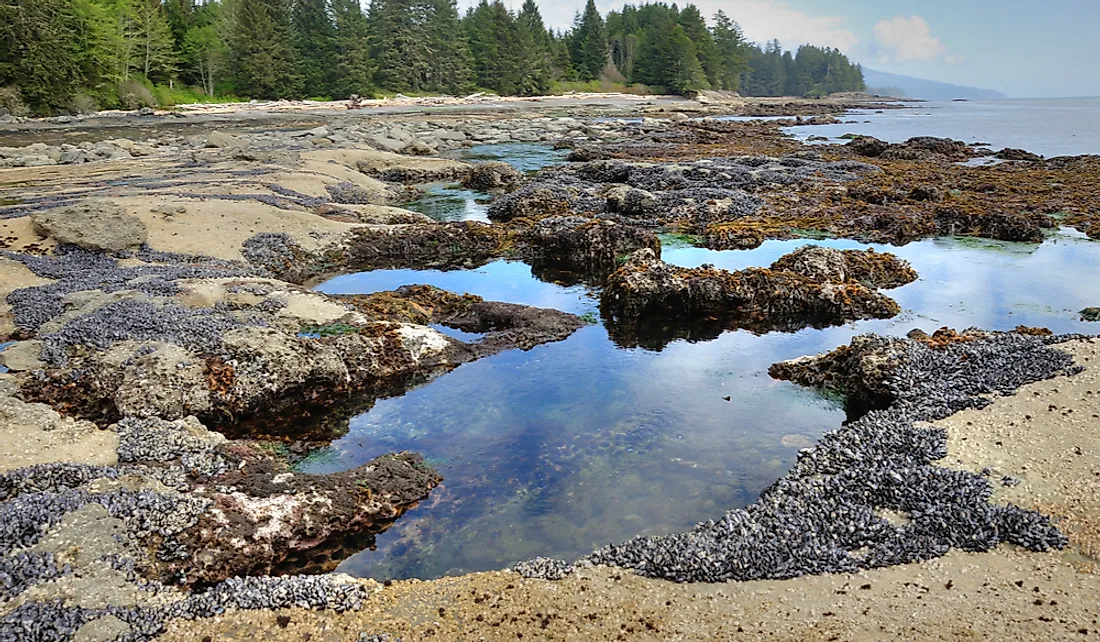What Is a Tide Pool?

Tide pools form when the sea or ocean tide moves from the rocky coastal areas leaving behind crevices and holes with ocean water trapped in them. The remaining water when the tide moves out forms a series of shallow or deep pools along the coastal rocky crevices. When the sea or ocean water rises during the high tide, the tidal pools are refilled again, in what is a continuous cycle. The marine life left behind in the tide pools gets exposed to harsh conditions. The fish and invertebrates left behind also get preyed upon by predators. Hence researchers describe the tide pool as the most competitive marine habitation in the sea and ocean, according to the Smithsonian Institute.
Ocean Tides
Ocean or sea tides occur due to the earth’s rotation and the moon’s strong gravitational pull on the earth according to the Coastal Institute. Since water is a liquid its responds to the moon’s gravitational force easily. The force of the tide, is strongest on the side of the earth that is facing moon. But on the opposite side of earth from the moon, the tide is weaker. This difference in gravitational forces results in the ocean waters bulging in two places at the same time. The high sea or ocean tide occurs on the side of the earth facing the moon, and the low tide occurs on the opposite side of the earth that’s away from the moon. This low tide causes a series of tide pools to be created on the sea or ocean coasts.
Tide Pool Zones
Like the sea or the ocean, a tide pool has zones of different depths. These are the splash, intertidal, and sub-tidal zones that each having varying densities of marine ecosystems.
Splash Zone
The splash zone at the top is the harshest for marine life. The only water present there is the infrequent mist or gush from sea or ocean waters. The splash zone is extremely hot due to sun exposure, and very salty due to constant evaporation. As a result, there is little marine life on it like some algae and sporadic barnacle arthropods.
Intertidal Zone
Below the splash zone is the intertidal zone which has more marine life. The intertidal zone has high, mid, and low intertidal zones created by the varying strength of tides daily. The high intertidal zone under the splash zone is covered by water only during the highest tides. In this zone, snails, barnacles, crabs, and anemone flowers begin to appear. From mid to low intertidal there is more water, food, and shelter, and the diversity and amount of marine increases. In these zones, crabs, sea stars, anemones, and snails are found from the mid to low intertidal zones.
Sub-Tidal Zone
The sub-tidal zone is the deepest and the final zone and water is always ever present here. Fish and marine invertebrates are found in this zone. This zone also has foraging areas for adult salmon, sea otters, seals and diving birds. The sub-tidal zone also has kelp forests that provide habitation for sea urchins and diverse marine invertebrates, and breeding ground for fish according to research by the U.S. National Park Service.
Benefits
Tide pools allow fishermen to easily catch fish, crabs, clams and mussels for consumption. In low tide zones, people can do aquaculture by planting edible plants, and rearing clams like the geoduck on the tide pools. But encroaching on tide pools by humans can disturb the harmony of marine ecosystem present in the tide pools and pollute them.











